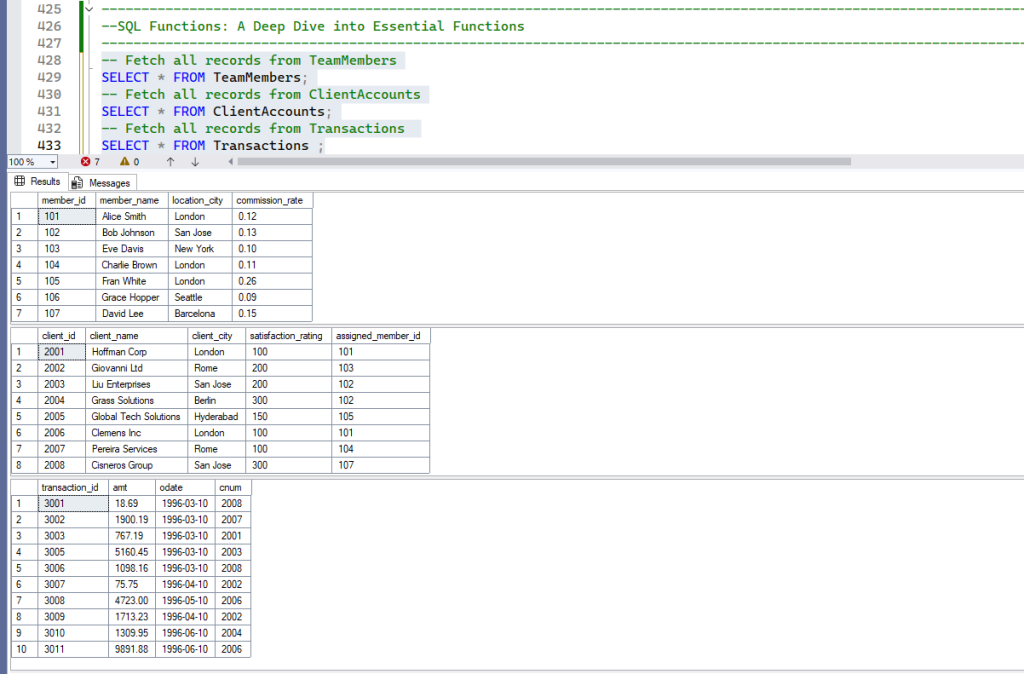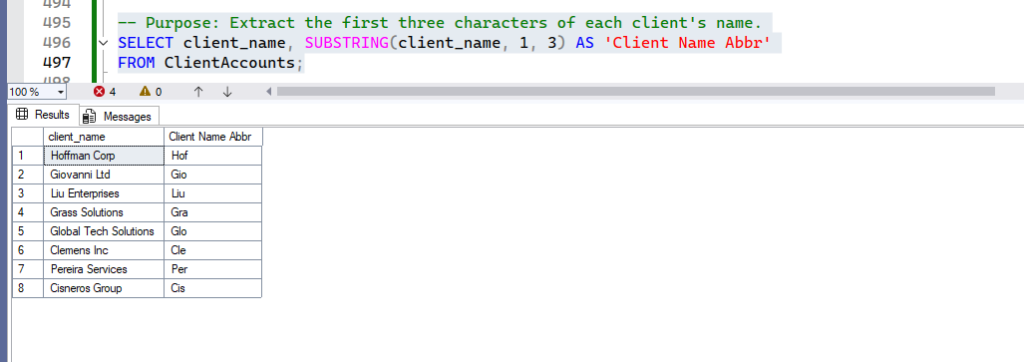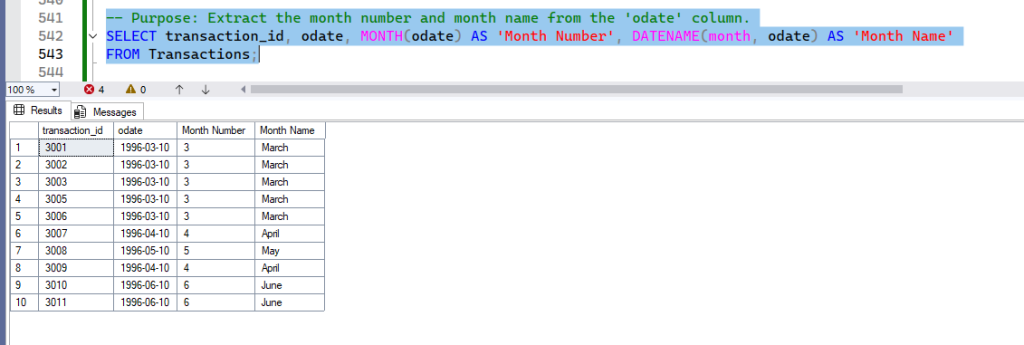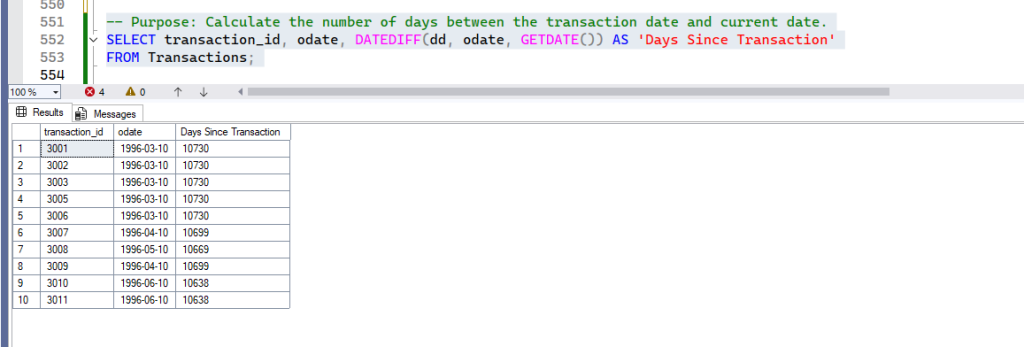Welcome back to our SQL journey! In our previous discussions, we’ve built a solid foundation – from setting up our database and defining its tables to manipulating data with DDL and DML commands, and even mastering various JOIN operations to link related information. Today, we’re taking another crucial step forward by delving into SQL Functions.
Getting Started with Our eCommerce Database
Before we dive into the fascinating world of SQL functions, let’s ensure we’re all on the same page regarding our database environment. Throughout this blog series, we’ve been working with a custom-built eCommerce database, complete with TeamMembers, ClientAccounts, and Transactions tables.
Are you already familiar with our eCommerce database setup?
If your answer is yes, fantastic! You’re ready to proceed.
If not, no worries at all! We’ve got you covered. To follow along with the examples in this post and prepare your environment, please refer to our previous blogs where we detail the database and table creation:
Setting up the database will ensure you can execute all the queries and gain hands-on experience as we move forward!
Ready? Let’s explore the different categories of SQL functions with practical examples, all within our familiar eCommerce database and its tables.
Viewing Our Tables
Before we proceed, let’s look at the current state of our tables with the initial data:
-- Fetch all records from TeamMembers
SELECT * FROM TeamMembers;
-- Fetch all records from ClientAccounts
SELECT * FROM ClientAccounts;
-- Fetch all records from Transactions
SELECT * FROM Transactions ;Run this queries and you will see –

What are SQL Functions?
In SQL, a function is a pre-defined set of operations that performs a specific task and returns a single value. They are powerful, built-in tools that help you perform calculations, manipulate data, and format results directly within your queries. Think of them as specialized calculators and transformers that operate on your data, allowing you to extract more meaningful insights from your raw data with less effort.
1. Aggregate Functions: Summarizing Your Data
Aggregate functions work on a set of rows and return a single summary value. They are indispensable for analytical tasks, providing quick insights into large datasets.
COUNT(): Tallying Your Records
This function counts the number of rows that match a specified criterion.
Syntax:
SELECT COUNT(column_name) FROM table_name;
SELECT COUNT(*) FROM table_name;Examples:
- Total number of team members:
-- Purpose: Count all records in the TeamMembers table.
SELECT COUNT(*) AS 'Total Team Members' FROM TeamMembers;Output:

- Total clients managed by each city:
-- Purpose: Group clients by their city and count the number of clients in each.
SELECT client_city, COUNT(client_id) AS 'Total Clients'
FROM ClientAccounts
GROUP BY client_city;Output:

SUM(): Adding Up Values
SUM() calculates the total sum of a numeric column.
Syntax:
SELECT SUM(column_name) FROM table_name;Example:
- Total value of all transactions:
-- Purpose: Calculate the sum of all 'amt' (transaction amount) values from the Transactions table.
SELECT SUM(amt) AS 'Total Transaction Value' FROM Transactions;Output:

- Total transaction value for each client:
-- Purpose: Group transactions by client number (cnum) and sum the amounts for each client.
SELECT cnum, SUM(amt) AS 'Client Total Value'
FROM Transactions
GROUP BY cnum;Output:

AVG(): Finding the Average
This function computes the average value of a numeric column.
Syntax:
SELECT AVG(column_name) FROM table_name;Example:
- Average transaction amount:
-- Purpose: Calculate the average of all 'amt' values from the Transactions table.
SELECT AVG(amt) AS 'Average Transaction Amount' FROM Transactions;Output:

MIN() & MAX(): Discovering Extremes
MIN() finds the smallest value in a column, while MAX() finds the largest.
Syntax:
SELECT MIN(column_name) FROM table_name;
SELECT MAX(column_name) FROM table_name;Example:
- Highest and lowest transaction amounts:
-- Purpose: Find the maximum and minimum 'amt' values in the Transactions table.
SELECT MAX(amt) AS 'Highest Transaction Amount', MIN(amt) AS 'Lowest Transaction Amount'
FROM Transactions;Output:

2. String Functions: Manipulating Text Data
String functions are essential for cleaning, formatting, and extracting information from text-based columns.
UPPER() & LOWER(): Changing Case
UPPER() converts all characters in a string to uppercase, and LOWER() converts them to lowercase. These are great for standardizing text data, ensuring consistency in comparisons and displays.
Syntax:
SELECT UPPER(column_name) FROM table_name;
SELECT LOWER(column_name) FROM table_name;Examples:
- Team member names in uppercase:
-- Purpose: Convert all 'member_name' values to uppercase for consistent display.
SELECT UPPER(member_name) AS 'Team Member Name (Uppercase)' FROM TeamMembers;Output:

- Client cities in lowercase:
-- Purpose: Convert all 'client_city' values to lowercase for standardization.
SELECT LOWER(client_city) AS 'Client City (Lowercase)' FROM ClientAccounts;Output:

CONCAT(): Joining Strings
CONCAT() allows you to combine two or more strings into a single string. This is useful for creating descriptive labels or full addresses.
Syntax:
SELECT CONCAT(string1, string2, ...) FROM table_name;Example:
- Combining team member name and city:
-- Purpose: Combine the team member's name and their location city into a single string, separated by a comma and space.
SELECT CONCAT(member_name, ', ', location_city) AS 'Member Location Info'
FROM TeamMembers;Output:

TRIM(): Removing Unwanted Spaces
TRIM() removes leading, trailing, or both leading and trailing spaces (or other specified characters) from a string. This is crucial for data consistency, especially when data entry might introduce extra spaces.
Syntax:
SELECT TRIM(column_name) FROM table_name WHERE TRIM(column_name) = 'value';Example:
- Finding clients in ‘London’ even with extra spaces:
-- Scenario: If a city name like ' London ' exists in the database, a direct comparison will fail.
--generate this usecase by adding extra space to city
update ClientAccounts set client_city = ' London' where client_id = 2006;
--This might miss some clients as we updated the record.
SELECT * FROM ClientAccounts WHERE client_city = 'London';
-- Now, by using TRIM we can remove any leading/trailing spaces from the 'client_city' column before comparison,
-- ensuring accurate results even with inconsistent spacing in the data.
SELECT * FROM ClientAccounts WHERE TRIM(client_city) = 'London';
--revert the change after testing this
update ClientAccounts set client_city = 'London' where client_id = 2006; SUBSTRING(): Extracting Parts of a String
SUBSTRING() extracts a portion of a string based on a specified starting position and length.
Syntax:
SELECT SUBSTRING(string, start_position, length) FROM table_name;Examples:
- Extracting initials from team member names:
-- Purpose: Extract the first character (initial) from the 'member_name' for each team member.
SELECT member_name, SUBSTRING(member_name, 1, 1) AS 'Member Initial'
FROM TeamMembers;Output:

- Extracting the first 3 characters of client names:
-- Purpose: Extract the first three characters of each client's name.
SELECT client_name, SUBSTRING(client_name, 1, 3) AS 'Client Name Abbr'
FROM ClientAccounts;Output:

LEN()/LENGTH(): Getting String Length
This function returns the number of characters in a string.
-- Purpose: Get the length of each team member's name.
SELECT member_name, LEN(member_name) AS 'Name Length' FROM TeamMembers;Output:

REPLACE(): Substituting Substrings
REPLACE() replaces all occurrences of a specified substring with another substring within a given string.
-- Purpose: Replace 'New York' with 'NYC' in the 'client_city' column for demonstration.
SELECT client_name, REPLACE(client_city, 'New York', 'NYC') AS 'Modified City'
FROM ClientAccounts;Output:

3. Math Functions: Performing Numerical Operations
SQL provides a suite of functions for mathematical calculations, from basic arithmetic to more complex operations.
ABS(): Absolute Value
Returns the absolute (non-negative) value of a number. Useful when dealing with differences or magnitudes where direction doesn’t matter.
Syntax:
SELECT ABS(number);Example:
-- Purpose: Demonstrate the absolute value of a negative number.
SELECT ABS(-100.50) AS 'Absolute Value'; -- Output: 100.50CEILING() & FLOOR(): Rounding to Integers
CEILING() rounds a number up to the nearest whole integer, while FLOOR() rounds it down.
Syntax:
SELECT CEILING(number);
SELECT FLOOR(number);Examples:
- Rounding up a commission rate:
-- Purpose: Round a hypothetical commission rate up to the next whole number.
SELECT CEILING(0.125 * 100) AS 'Ceiling Commission%'; -- If commission was 12.5%, rounds to 13.- Rounding down a transaction amount:
-- Purpose: Round a transaction amount down to the nearest whole number.
SELECT FLOOR(18.69) AS 'Floor Amount'; -- Output: 18ROUND(): Precision Rounding
ROUND() rounds a number to a specified number of decimal places. This is essential for financial calculations and display.
Syntax:
SELECT ROUND(number, decimal_places);Example:
- Rounding a transaction amount to two decimal places:
-- Purpose: Round a hypothetical transaction amount to exactly two decimal places.
SELECT ROUND(1900.1945, 2) AS 'Rounded Amount'; -- Output: 1900.19SQUARE() & SQRT(): Power and Roots
SQUARE() returns the square of a number (number * number), and SQRT() returns its square root.
Syntax:
SELECT SQUARE(number);
SELECT SQRT(number);Examples:
- Squaring a commission rate (for hypothetical variance calculation):
-- Purpose: Demonstrate squaring a commission rate.
SELECT commission_rate, SQUARE(commission_rate) AS 'Squared Commission'
FROM TeamMembers
WHERE member_id = 1001; -- Using a specific member for demonstration- Square root of a transaction amount (hypothetical use):
-- Purpose: Demonstrate the square root of a transaction amount.
SELECT amt, SQRT(amt) AS 'Amount Square Root'
FROM Transactions
WHERE transaction_id = 3001; -- Using a specific transaction for demonstrationPOWER(): Raising to a Power
POWER() returns the value of a number raised to the power of another number.
Syntax:
SELECT POWER(base, exponent);Example:
- Calculating compounded commission (hypothetical):
-- Purpose: Demonstrate raising a commission rate (e.g., 1.15 for 15% increase) to a power.
SELECT POWER(1.15, 2) AS 'Compounded Factor'; -- (1.15)^24. Date Functions: Working with Dates and Times
Date functions are crucial for analyzing time-sensitive data, allowing you to extract components, calculate differences, and format dates. We’ll use the odate column from our Transactions table.
GETDATE()/CURRENT_TIMESTAMP: Current Date and Time
GETDATE() (or CURRENT_TIMESTAMP in many SQL dialects) returns the current date and time of the system where the SQL Server is running.
Syntax:
SELECT GETDATE();Example:
-- Purpose: Get the current date and time from the system.
SELECT GETDATE() AS 'Current System Date Time'; -- Returns current date and time, e.g., '2025-07-22 22:15:00.000'Output:

MONTH(), YEAR(), DATENAME(): Extracting Date Components
These functions extract specific parts of a date, such as the month number, year, or the name of the month/day.
Syntax:
SELECT MONTH(date_column);
SELECT YEAR(date_column);
SELECT DATENAME(date_part, date_column);date_part can be month, year, day, weekday (dw), etc.
Examples:
- Month number and name from transaction dates:
-- Purpose: Extract the month number and month name from the 'odate' column for each transaction.
SELECT transaction_id, odate, MONTH(odate) AS 'Month Number', DATENAME(month, odate) AS 'Month Name'
FROM Transactions;Output:

- Year-wise and month-wise total transaction amounts:
-- Purpose: Calculate total transaction amounts grouped by the year and month.
SELECT YEAR(odate) AS 'Year', DATENAME(month, odate) AS 'Month', SUM(amt) AS 'Total Transaction Amount'
FROM Transactions
GROUP BY YEAR(odate), MONTH(odate), DATENAME(month, odate) -
ORDER BY YEAR(odate), MONTH(odate); Output:

DATEDIFF(): Calculating Date Differences
DATEDIFF() calculates the difference between two dates based on a specified date part (e.g., days, months, years).
Syntax:
SELECT DATEDIFF(date_part, start_date, end_date);Common date_part values include dd (day), mm (month), yy (year), hh (hour), mi (minute), ss (second).
Example:
- Days since a transaction was recorded:
-- Purpose: Calculate the number of days between the transaction date ('odate') and the current system date.
SELECT transaction_id, odate, DATEDIFF(dd, odate, GETDATE()) AS 'Days Since Transaction'
FROM Transactions;Output:

DATEADD(): Adding to Dates
This function adds a specified number of date_part units to a date. It’s incredibly useful for projecting future dates, setting deadlines, or calculating expiry dates.
-- Purpose: Add 30 days to each transaction date, to estimate a hypothetical follow-up date.
SELECT transaction_id, odate, DATEADD(day, 30, odate) AS 'Follow-up Date'
FROM Transactions;Output:

Conclusion
SQL functions are fundamental building blocks for sophisticated data analysis and manipulation. By mastering aggregate, string, math, and date functions, you gain immense power to transform raw data into valuable insights, prepare data for reporting, and handle diverse data types with ease. Consistent use of these functions ensures data integrity and efficiency in your database operations, making your queries more robust and flexible.
The functions covered in this blog are some of the most commonly used and essential ones, but they are by no means the only tools in SQL’s vast arsenal. The world of SQL functions is incredibly rich, offering specialized functions for every conceivable data manipulation need, including advanced analytical functions, system functions, and user-defined functions that you can create yourself.
We highly encourage you to explore further and deepen your understanding. A great place to start is the official Microsoft documentation, which provides a comprehensive reference for all T-SQL functions: SQL Server Functions. Continuous learning and experimentation are key to becoming a proficient SQL developer!
Stay tuned for our next blog, where we’ll continue to explore more advanced SQL concept – Triggers!

Leave a Reply
You must be logged in to post a comment.